Alumnus speaks on the role of LGBT in the media
Stephen Tropiano, a professor at Ithaca College and alumnus of the School of Cinematic Arts, spoke Wednesday afternoon at the Annenberg School for Communication and Journalism on the history of the portrayal of the LGBT community in the media. His speech focused particularly on LGBT representation in television and closely followed his book The Prime Time Closet: A History of Gays and Lesbians on TV.
Tropiano showed multiple segments throughout television history where the LGBT community was mentioned and touched on modern shows like Orange is the New Black in order to comment on the positive and negative construction of homosexuals in the media.
He started by tracing the change in the discourse of the LGBT community from the ancient Greek era to the modern era in religious, medical, legal and cultural spaces. According to Tropiano, ancient Greeks did not have a categorization for someone who was gay, and that the modern world’s categorization has come from stereotypes and social myths.
“In [ancient Greece], there wasn’t anything like homosexuality,” Tropiano said. “It wasn’t called that because sexuality was more about your position in Athens, for example. They didn’t really have the categories that we have, but as we go over time into the 19th and into the 20th century, we have become more increasingly categorized.”
Tropiano briefly summarized the history of the LGBT community in America and how the rest of society constructed it. Following World War II, members of the gay community were discriminated against for being in collusion with communist sympathizers, and it wasn’t until 1973 that the American Psychiatric Association removed homosexuality from its list of disorders.
One of the first references in television to the LGBT community came from a PBS newscast that attempted to explain what it means to be gay. Tropiano argued that many of the initial non-fiction reports on members of the gay community immediately categorized them and perpetuated today’s stereotypes on television.
“They had titles like ‘Homosexuals and the Problems That They Present,’ ‘Homosexuals Who Stalk and Molest Children,’ ‘Introduction to the Problem of Homosexuality’ because homosexuality was always considered a problem,” Tropiano said. “The stereotype of the homosexual child molester are two things that were often conflated and two things that are obviously very different. The idea of equating a homosexual with a pedophile actually continued when they dealt with the subject on television.”
Tropiano categorized the portrayal of members of the gay community in television into different genres. He further elaborated on how these portrayals harmed the LGBT community. He concluded this analysis of different genres by describing how they have played a role in both informing the public about differing sexualities as well as perpetuating the social myths surrounding the LGBT community.
“Television has played somewhat of a dual role because on one hand, it has perpetuated or promoted false social myths and stereotypes, but on the other hand, it has actually done a lot of good in terms of subverting it,” Tropiano said.
In more recent representations of the LGBT community, controversy has arisen in television regarding what can and cannot be shown. Tropiano pointed to edgier dramas like Soap and Picket Fences to illustrate some of the problems that arose with the portrayal of the LGBT community.
“One of the problems that shows ran into with gay characters was [that] if you are going to put a gay character as a regular on a show -— and that began in the 1970s — that presents sort of a problem, because you couldn’t do what you could do with a heterosexual with a gay man or even a lesbian,” Tropiano said.
As Tropiano moved into more modern issues in streaming services and the internet, a discussion emerged on how the LGBT community is depicted in the current media space. Tropiano explained that increased LGBT representation has occurred because of the creative freedom that streamed shows have that broadcast shows do not and also because of the changing culture.
“The reason why people are flocking to Amazon and Hulu as well as HBO and so on is they are given more creative freedom,” Tropiano said. “They aren’t looking over people’s shoulders. I also do think part of it is because the culture has changed, and I think that society has changed.”

